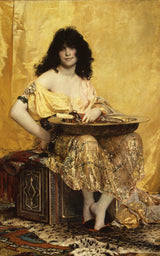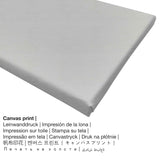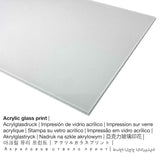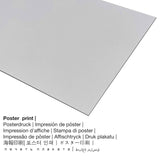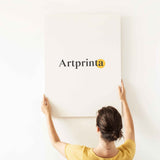Henri Regnault, 1870 - Salome - mbipụta nka mara mma
Ụtụ gụnyere. Mbupu gbakọrọ na ndenye ọpụpụ.
Nkọwapụta edemede
Salomi was made by Henri Regnault in 1870. The 150 years old version of the masterpiece had the size of 63 x 40 1/2 na (160 x 102,9 cm). Mmanụ na kwaaji was used by the European artist as the technique for the artpiece. Today, this artwork is in the the Ụlọ ihe ngosi nka nke Metropolitan mkpokọta nka, nke bụ otu n'ime ụlọ ngosi nka nka kachasị ukwuu na nke kachasị mma n'ụwa, nke gụnyere ihe karịrị nde abụọ ọrụ nka nke gbara puku afọ ise nke ọdịbendị ụwa, site na prehistory ruo ugbu a na site n'akụkụ ọ bụla nke ụwa .. Site n'ikike nke The Metropolitan Museum of Art, New York, Gift of George F. Baker, 1916 (ikike ngalaba ọha). Ihe kredit nke ọrụ nka bụ nke a: Gift of George F. Baker, 1916. Ọzọkwa, nhazi ahụ bụ eserese ma nwee oke onyonyo nke 2: 3, nke pụtara na ogologo bụ 33% mkpụmkpụ karịa obosara. Henri Regnault was a male painter, whose style can be attributed primarily to Romanticism. The Romanticist artist was born in 1843 na Paris, Ile-de-France, France ma nwụọ mgbe ọ dị afọ 28 na 1871.
Họrọ ụdị ngwaahịa ngwaahịa gị
Maka mbipụta nka ọ bụla anyị na-enye ihe dị iche iche & nha dị iche iche. Ị nwere ike ịhọrọ n'ime nhọrọ nhazi ngwaahịa ndị a:
- Mbipụta nke aluminom: An Aluminium Dibond print is a print material with a true depth effect - for a modern impression and non-reflective surface structure. The Direct Print on Aluminum Dibond is the best start to fine art reproductions on aluminum. The bright & white sections of the original artpiece shine with a silky gloss but without any glow. The colors of the print are bright and luminous in the highest definition, fine details of the print are very clear, and you can literally notice the matte appearance. This UV print on Aluminum Dibond is the most popular entry-level product and is an extremely sophisticated way to display fine art prints, as it puts the viewer’s attention on the whole artwork.
- Mbipụta kanvas: A printed canvas, which shall not be confused with a canvas painting, is a digital image printed on a canvas material. How can I hang a canvas print on my wall? The great advantage of canvas prints is that they are relatively low in weight. This means, it is quite simple to hang the Canvas print without any wall-mounts. That is why, canvas prints are suitable for all kinds of walls.
- Ihe odide acrylic glass: A glossy acrylic glass print, often referenced as a fine art print on plexiglass, transforms an artwork into lovely wall decoration. The major upside of a plexiglass fine art copy is that contrasts as well as small painting details will be visible due to the precise tonal gradation. The plexiglass protects your selected fine art print against light and heat for many more years to come.
- Mbipụta akwụkwọ mmado (ihe kwaaji): Our poster print is a UV printed sheet of canvas with a fine structure on the surface. A poster print is best used for placing the art copy with the help of a custom-made frame. Please keep in mind, that depending on the absolute size of the poster print we add a white margin of around 2 - 6cm round about the print in order to facilitate the framing with your custom frame.
Legal disclaimer: We try our utmost in order to depict the products as clearly as possible and to illustrate them visually on the various product detail pages. At the same time, the tone of the printing material, as well as the imprint can vary marginally from the representation on the screen. Depending on the screen settings and the nature of the surface, color pigments may not be printed as exactly as the digital version. In view of the fact that all the art reproductions are processed and printed by hand, there might as well be minor discrepancies in the motif's exact position and the size.
Ngwaahịa a
| Nkewa ngwaahịa: | mmepụta nka |
| Mmeputakwa: | dijitalụ mmeputakwa |
| Produzọ mmepụta: | Mbipụta UV ozugbo (mbipụta dijitalụ) |
| Nlụpụta: | emepụtara na Germany |
| Ụdị ngwaahịa: | na mmepụta ihe |
| Ojiji ngwaahịa: | mgbidi mgbidi, mgbidi ịchọ mma |
| Nhazi onyonyo: | usoro eserese |
| Ụdị anya: | 2: 3 |
| Nkọwa nke oke akụkụ: | ogologo bụ 33% mkpụmkpụ karịa obosara |
| Nhọrọ ihe onwunwe: | ígwè obibi akwụkwọ (aluminium dibond), ebipụta canvas, mbipụta enyo acrylic (nwere ezigbo mkpuchi iko), mbipụta akwụkwọ mmado (akwụkwọ kwaaji) |
| Mbipụta kanvas (akwa akwa na etiti ihe ndọtị) dị iche iche: | 20x30cm - 8x12", 40x60cm - 16x24", 60x90cm - 24x35" |
| Mbipụta iko acrylic (nwere ezigbo mkpuchi iko) dị iche iche: | 20x30cm - 8x12", 40x60cm - 16x24", 60x90cm - 24x35" |
| Nhọrọ nke mbipụta akwụkwọ mmado (akwụkwọ kwaaji): | 40x60cm - 16x24", 60x90cm - 24x35" |
| Aluminium dibond ebipụta (ihe aluminium) dị iche iche: | 20x30cm - 8x12", 40x60cm - 16x24", 60x90cm - 24x35" |
| Nhazi mbipụta nka: | agunyeghi |
Ozi nka ahaziri
| Aha nka: | "Salom" |
| Nhazi nka nka: | sere |
| Otu sara mbara: | nkà nke oge a |
| Time: | 19th narị afọ |
| Afọ okike: | 1870 |
| Afọ nka: | ihe karịrị 150 afọ |
| Ọkara nke ihe osise izizi: | mmanụ na kwaaji |
| Ogo nke ọrụ nka izizi: | 63 x 40 1/2 na (160 x 102,9 cm) |
| Ụlọ ihe ngosi nka: | Museumlọ ihe ngosi nka nke Obodo |
| Ebe ngosi nka: | New York City, New York, Njikota Obodo Amerika |
| website: | Museumlọ ihe ngosi nka nke Obodo |
| Akwụkwọ ikike nka: | ngalaba ọha |
| Site n'aka: | The Metropolitan Museum of Art, New York, Gift of George F. Baker, 1916 |
| kreditline ọrụ nka: | Gift of George F. Baker, 1916 |
Nyocha ngwa ngwa nke onye na-ese ihe
| Ihe nkiri: | Henri Regnault |
| Aha utu aha: | Regnault, Alexandre-Georges-Henri Regnault, Regnault H., Regnault Alexandre Georges Henri, Regnault Alexandre-Georges-Henri, Henri Alexandre Georges Regnault, Alexandre Georges Henri Regnault, H. Regnault, Regnault Henri A., Regnault Henri Alexandre Georges, Regnault Henri, Henri Regnault |
| okike onye nka: | nwoke |
| Nationality: | French |
| Ọrụ: | onye na-ese ihe |
| Obodo obibi: | France |
| Nkewa onye nka: | omenkà nke oge a |
| styles: | Ihunanya |
| Afọ ọnwụ: | 28 afọ |
| Afọ amụrụ: | 1843 |
| Ebe amụrụ onye: | Paris, Ile-de-France, France |
| Nwụrụ n'afọ: | 1871 |
Edobere ederede a site na nwebisiinka © - Artprinta (www.artprinta.com)
Nkọwapụta izugbe sitere na The Metropolitan Museum of Art (© - Ụlọ ihe ngosi nka nke obodo ukwu - Museumlọ ihe ngosi nka nke Obodo)
Regnault initially represented this Italian model as an African woman, but later enlarged his canvas at the bottom and right and transformed it into a representation of the biblical temptress Salomé. Hair ruffled, clothes in disarray, she has just danced for her stepfather Herod, governor of Judea. The platter and knife allude to her reward: the severed head of John the Baptist. Just months after this picture’s sensational debut at the Salon of 1870, the young Regnault was killed in the Franco-Prussian War. His posthumous fame was such that an outcry arose when the painting left France for America in 1912.

